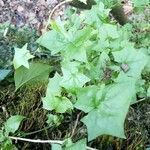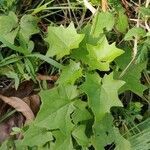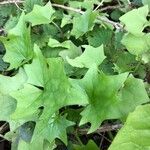Climbers to c. 3 m high, ± glabrous. Leaves: petiole 4–7 cm long; lamina to c. 8 cm long, broadly ovate to rotund, lobate, deeply cordate at base, entire. Capitula many per branch; peduncle to c. 10 mm long at maturity; calycular bracteoles 2–4, narrowly oblong to oblanceolate, 2–3 mm long; involucre 3–4 mm long, c. 2 mm diam.; bracts 7–10; stereome flat or slightly ridged proximally, thin, with 1 (or 2) ducts; margin of receptacular pits raised. Florets c. 10–12; corolla c. 5 mm long, c. 0.5 mm diam. at base, exceeding involucre by 3–4 mm; limb c. ⅖ of total length. Achenes obloid, c. 2 mm long, pale brown, prominently 10-ribbed, glabrous or with sparse hairs. Pappus 5–6 mm long, white; bristles minutely scabrid-barbellate.
Slender, herbaceous twiner, ± succulent, all parts ± glabrous. Leaves up to 70 x 80 mm, deltoid-ovate in outline, sharply 3-5-lobed on either side, sinuses broad, base cordate to hastate; petioles ± as long as blade, often twisted, usually with 2 small leaf-like basal auricles. Capitula discoid, many in congested, compound, corymbose panicles, terminating in short lateral branchlets; involucre narrowly campanulate; bracts 8, ± 3 mm long, resinous, calyculus bracts few, short; flowers bright yellow. Flowering time Apr.-June. Cypselae oblong, 2 mm long, glabrous, ribbed; pappus of many fine bristles.
Herbaceous climber. Leaves fleshy, cordate, 5-7-lobed, broadly toothed, palmately veined, petiolate, eared at base. Flower heads discoid, in dense corymbs on lateral branches, yellow.







